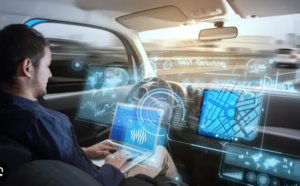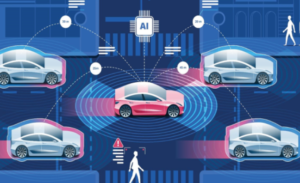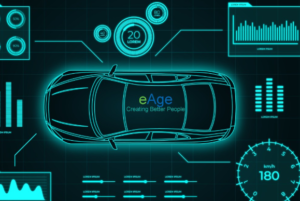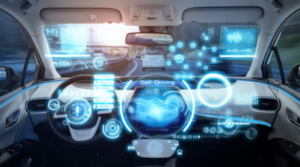
The concept of autonomous vehicles (AVs) has been a topic of fascination for decades, and with recent advancements in artificial intelligence (AI), this futuristic vision is becoming a reality. AI plays a crucial role in enabling self-driving cars to navigate roads, understand their surroundings, and make decisions in real time. As the technology continues to evolve, autonomous vehicles are set to revolutionize the future of transportation, offering increased safety, efficiency, and convenience.
1. How AI Powers Autonomous Vehicles
At the heart of autonomous vehicles lies a complex network of AI algorithms and sensors that allow these vehicles to perceive, interpret, and interact with their environment. Here’s how AI drives the core functions of AVs:
– Perception and Environment Understanding: Autonomous vehicles rely on a variety of sensors, including cameras, LiDAR, radar, and ultrasonic sensors, to gather data about their surroundings. AI algorithms process this data to create a comprehensive understanding of the vehicle’s environment. For instance, computer vision, a branch of AI, enables the car to detect and classify objects such as pedestrians, cyclists, other vehicles, traffic signs, and road markings. This information is crucial for safe navigation and decision-making.

– Localization and Mapping: Autonomous vehicles need to know their precise location on the road to navigate effectively. AI uses data from GPS, sensors, and pre-mapped information to achieve accurate localization. High-definition maps, combined with real-time sensor data, allow AVs to understand their position within a few centimeters. AI also helps in updating these maps dynamically to reflect changes in the environment, such as road construction or new obstacles.
– Path Planning and Decision Making: AI plays a crucial role in the decision-making process of autonomous vehicles. Machine learning algorithms analyze real-time data to predict the behavior of surrounding objects and plan the vehicle’s path accordingly. This includes decisions such as when to change lanes, adjust speed, or make turns. AI must consider various factors like traffic rules, road conditions, and the actions of other road users to make safe and efficient driving decisions.
– Control and Execution: Once the AI system determines the best course of action, it sends commands to the vehicle’s control systems to execute maneuvers. This involves accelerating, braking, and steering the vehicle with high precision. AI ensures that these actions are performed smoothly and in coordination with the vehicle’s sensors and other systems.
2. Levels of Autonomous Driving
The Society of Automotive Engineers (SAE) defines six levels of driving automation, ranging from Level 0 (no automation) to Level 5 (full automation):

– Level 0: No automation. The human driver is in complete control of the vehicle.
– Level 1: Driver assistance. The vehicle can control either steering or acceleration/deceleration, but not both simultaneously.
– Level 2: Partial automation. The vehicle can control both steering and acceleration/deceleration, but the human driver must remain engaged and monitor the environment.
– Level 3: Conditional automation. The vehicle can perform most driving tasks, but human intervention is required in certain situations.
– Level 4: High automation. The vehicle can operate autonomously in specific conditions or environments without human intervention.
– Level 5: Full automation. The vehicle is capable of complete autonomous operation in all conditions and environments, with no human input needed.
AI is crucial for achieving higher levels of autonomy, particularly Levels 4 and 5, where the vehicle must be capable of handling complex and unpredictable scenarios without human intervention.
Also read:The Future of AI in Healthcare: Transforming Diagnostics, Treatment, and Patient Care
3. Benefits of AI-Driven Autonomous Vehicles
The integration of AI in autonomous vehicles offers numerous benefits that can transform the future of transportation:
– Enhanced Safety: One of the primary motivations behind the development of autonomous vehicles is the potential to significantly reduce road accidents. Human error is a leading cause of traffic accidents, often due to factors like distracted driving, fatigue, or impaired judgment. AI-driven vehicles can make split-second decisions, avoid collisions, and adhere to traffic rules consistently, leading to safer roads.
– Increased Efficiency and Reduced Traffic Congestion: AI enables autonomous vehicles to communicate with each other and with traffic infrastructure, optimizing traffic flow and reducing congestion. For example, self-driving cars can maintain optimal speeds, reduce sudden braking, and follow more efficient routes, minimizing travel time and fuel consumption. This could lead to more efficient use of road networks and reduced carbon emissions.
Top 10 AI Applications Transforming Everyday Life
– Improved Accessibility and Mobility: Autonomous vehicles have the potential to provide mobility solutions for individuals who cannot drive, such as the elderly, disabled, or visually impaired. AI-driven vehicles can offer on-demand transportation services, enhancing independence and improving the quality of life for these individuals.
– Reduced Transportation Costs: AI-powered autonomous vehicles can lower transportation costs by reducing the need for human drivers and optimizing fuel consumption. In the long term, this can lead to more affordable ride-sharing services and goods delivery, making transportation more accessible and cost-effective.
4. Challenges and Ethical Considerations
While the future of AI in autonomous vehicles is promising, several challenges and ethical considerations need to be addressed:
– Safety and Reliability: Ensuring the safety and reliability of autonomous vehicles is paramount. AI systems must be rigorously tested to handle a wide range of driving scenarios, including adverse weather conditions and complex traffic situations. Additionally, there must be mechanisms to handle system failures and ensure passenger safety.
– Ethical Dilemmas: Autonomous vehicles may face ethical dilemmas where they must make decisions that involve trade-offs, such as choosing between the safety of the occupants and pedestrians in an unavoidable collision scenario. Developing ethical frameworks for AI decision-making in such situations is a complex challenge that requires input from various stakeholders, including ethicists, engineers, policymakers, and the public.
also read:The Future of Personalized Recommendations: How AI is Transforming Choices
– Regulatory and Legal Issues: The widespread adoption of autonomous vehicles requires a robust regulatory framework to address issues such as liability in the event of accidents, data privacy, and cybersecurity. Governments and regulatory bodies need to develop clear guidelines and standards to ensure the safe deployment of autonomous vehicles on public roads.

5. The Road Ahead: The Future of Autonomous Vehicles
As AI technology continues to advance, the future of autonomous vehicles looks increasingly promising. In the coming years, we can expect to see the gradual integration of self-driving cars into public transportation systems, ride-sharing services, and long-haul trucking.
– Urban Mobility and Smart Cities: Autonomous vehicles will play a key role in the development of smart cities, where they will be integrated into intelligent transportation systems. AI-driven vehicles can provide efficient, on-demand public transportation services, reducing the need for private car ownership and decreasing urban congestion.
– Freight and Logistics: Autonomous trucks and delivery vehicles have the potential to revolutionize the logistics industry by offering more efficient and reliable transportation of goods. AI-driven vehicles can operate around the clock, reducing delivery times and costs while minimizing human labor.
also read:The Future of AI Virtual Assistants and Home Modernization
– Collaboration with Other Emerging Technologies: The future of autonomous vehicles will likely involve collaboration with other emerging technologies such as 5G connectivity, the Internet of Things (IoT), and blockchain. These technologies can enhance vehicle-to-everything (V2X) communication, improve data security, and support real-time decision-making for autonomous vehicles.
In conclusion, AI is at the forefront of the autonomous vehicle revolution, offering the potential to transform the future of transportation. While challenges remain, the benefits of safer roads, increased mobility, and improved efficiency make AI-driven autonomous vehicles a promising solution for the future. As technology continues to evolve, autonomous vehicles will become an integral part of our daily lives, reshaping how we travel and move goods in the decades to come.
visit: gamicaltech.com
